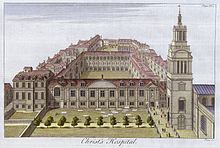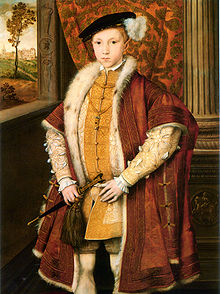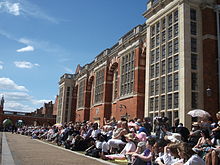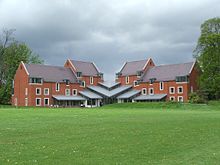- Christ's Hospital
-
For the charity in Abingdon, Oxfordshire, England, see Christ's Hospital of Abingdon.For the New Jersey hospital, see Christ Hospital (Jersey City, New Jersey).
Christ's Hospital Motto Honour All Men, Love the Brotherhood, Fear God, Honour the King. Established 1552 Type Independent school Religion Anglican President HRH The Duke of Gloucester Headmaster Mr John Franklin BA MEd Admin Senior Chaplain Revd Steve Golding BSc BA Chairman of the Council of Almoners Garry Johnson Founder Edward VI Location Horsham
West Sussex
RH13 0YP
United KingdomStudents 831: 412 girls & 419 boys (2008) Gender Coeducational Ages 11–18 Houses 18 Boarding Houses Colours Blue & Yellow
Publication Housey! Magazine The Blue Grades 71% A/A* at GCSE, 80% A/B at A-level Main Sports Football, Rugby, Hockey, Cricket Former Pupils Old Blues Website christs-hospital.org.uk Coordinates: 51°02′39″N 0°21′47″W / 51.044167°N 0.363056°W
Christ's Hospital (popularly known as The Bluecoat School, and also by the nicknames "Housey" and "CH") is an English coeducational independent day and boarding school with Royal Charter located in the Sussex countryside just south of Horsham in Horsham District, West Sussex, England. It is a charity school, giving children from poorer backgrounds the chance to have a better education. The school was originally founded in the 16th century in Greyfriars, London and Hertford.
Contents
The charitable foundation
Christ's Hospital is almost unique for a British independent school in that it educates a proportion of its students free, and most at a reduced rate. This stems from its founding charter as a charitable school. School fees are paid on a means-tested basis, with substantial subsidies paid by the school, so that pupils from all walks of life are able to have a high quality, independent school education that would otherwise be beyond the means of their parents.
In 2005/6 82% of children attending CH came from state or grant-maintained schools[citation needed]. In 2006 19% of children accepting places were assessed as being in "very high" need, 64% in "medium to high" need and 17% in "low" need.[1]
The trustees of the foundation are the Council of Almoners, chaired by the Treasurer of Christ's Hospital, who govern the foundation according to a Scheme of Administration granted by the Charity Commission. The historic Court of Governors survives as a formal institution consisting of over 650 benefactors but its powers have since the 19th century been largely transferred to the smaller Council of Almoners.
In 2007 Christ's Hospital was formally separated into two related registered charities: Christ's Hospital Foundation[2] and Christ's Hospital School.[3]
Admissions
Admission of pupils is either by open competitive examination or by "presentation" — in either case the suitability of candidates is judged according to criteria of need and parental income. Certain individuals and corporate bodies exercise rights of presentation, proposing suitable candidates for admission. In effect the selection of pupils is made according to a complex set of scholarships.
- Donation Governors are individuals who, in return for a financial donation, can propose a suitable candidate.
- A number of livery companies have rights of presentation, including the Ironmongers' Company, the Cooks' Company, the Drapers' Company, the Grocers' Company, the Fishmongers' Company, the Skinners' Company, the Mercers' Company, the Master Mariners' Company and others.
- The Guild of Freemen of the City of London have rights of presentation.
- The Council of Almoners exercises rights of presentation in respect of:
- Distinguished Service Presentation: sons, daughters, grandsons or granddaughters of persons distinguished in literature, science or art, the service of the Crown or services to Christ's Hospital (established 1866).
- Royal Mathematical School: sons or daughters of Royal Navy, Royal Marines or Royal Navy Reserve List 1 (Merchant Navy) personnel
- Girls' Additional Endowment Fund: orphan daughters of various professions (trust established 1904/5)
- Brodribb Foundation: blood relations of members of the Brodribb family (established 1927)
- Almoners' Presentees: supplementary places should the number of children presented fall short of vacancies available
In the open competitive examination, precedence is given to candidates who satisfy the conditions of a number of trusts, including:
- children from schools in the area formerly controlled by the Inner London Education Authority
- children from schools in certain ancient country parishes
- Oliver Whitby Educational Foundation: children from Chichester
- Royal Air Force Foundation: sons and daughters of officers or men of the Royal Air Force, Royal Auxiliary Air Force or Royal Air Force Reserve. The Foundation was instituted by Barnes Wallis using the money he received from the Royal Commission on Awards for Inventors for inventing the bouncing bomb
- Reeve's Foundation: children of parents connected with the ecclesiatical parish of St. Sepulchre in the City of London or the parish of Clerkenwell or St. Andrews, Holborn
- West's Gifts: children of parents resident in the borough of Newbury, borough of Reading, parish of Twickenham (1911 boundaries) or in default any contiguous parish or place thereto. Preference in respect of a third of the places is given to children who can establish a relationship to the founders of the trust, John West (born 1640, Master of the Clothworkers' Company and witness to the will of Samuel Pepys) and Frances West (his wife, born 1643) with the charity paying up to 50% of the pupils school fees.[4][5]
- Almoners' Nominees are those selected for admission as a result of the competitive examination without satisfying any other means of presentation.
Some of the means of entry are denoted on the uniform by a round metal plate (varying in design according to type of presentation) sewn on the breast of the housey coat.
History
Christ’s Hospital was the result of the vision of King Edward VI, assisted by Nicholas Ridley, Bishop of London, and Sir Richard Dobbs, Lord Mayor of the City of London. Its genesis was the earlier dissolution of the monasteries and the resultant overflow onto the streets of the poor and destitute. Encouraged by a sermon from Ridley, exhorting mercy to the poor, the King wrote to the Lord Mayor encouraging him to action. This he did via a committee of 30 merchants. Henry VIII had already granted the use of Greyfriars to the City for the relief of the poor. Edward granted the Palace of Bridewell, his lands at the Savoy, and rents and other chattels to create three Royal Hospitals — Bridewell Hospital (now the King Edward's School, Witley, Surrey), St Thomas' Hospital and Christ's Hospital, which was for the education of poor children.
The first boys and girls entered the school in Newgate in 1552. The Royal Charter was granted and signed by its Founder, Edward VI, the following year. The first Treasurer was Richard Grafton. The Protestant Foundation survived the Marian period and in the 1560s sent its first scholars to Oxford and Cambridge.
The school occupied Newgate as its major site for 350 years, but from time to time children were housed in other parts of the country. 32 children perished during the Great Plague of 1665. In the following year the Great Fire of London destroyed much of the Hospital except four cloisters and three wards, but there were no casualties among the children. Around 200 pupils were sent to Islington and Clerkenwell and then to Ware and Hertford. By the end of the 17th century the buildings had been rebuilt with the assistance of Sir Christopher Wren, a Governor of Christ's Hospital, and Nicholas Hawksmoor who designed the Writing School (1696). The church of Christ Church Newgate Street, designed by Wren, replaced the damaged choir of the former Greyfriars' church, and served as a place of worship for the children of Christ's Hospital in the City until the move to Horsham.
Christ's Hospital was given its second Royal Charter by Charles II in 1673. This charter specifically created the Royal Mathematical School whose original purpose was to train mathematicians and navigators who would serve as naval officers or merchant seafarers. Samuel Pepys, Secretary to His Majesty's Navy and from 1699 Vice President of Christ's Hospital, made a considerable contribution to Christ's Hospital. Isaac Newton, Jonas Moore, John Flamsteed, and Edmund Halley contributed to plans for the course of study of the new school within the foundation.
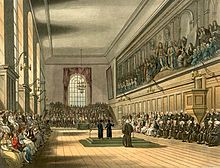 This early 19th-century picture shows the Great Hall on St. Matthew's Day, 21 September. On this day, two Grecians destined for scholarships to Oxford and Cambridge Universities gave orations in praise of the school, one in Latin and the other in English. The Verrio painting can be seen along the wall on the right.
This early 19th-century picture shows the Great Hall on St. Matthew's Day, 21 September. On this day, two Grecians destined for scholarships to Oxford and Cambridge Universities gave orations in praise of the school, one in Latin and the other in English. The Verrio painting can be seen along the wall on the right.
The girls settled at Hertford from 1707. The Governors had been paying a teacher in Hertford from 1653, and the removal of some children from London following the Great Fire strengthened the link with the town. In 1761, 200 boys under the age of 10 along with the boys from Ware were relocated to Hertford. In 1778 the last girls were moved out of London to join the others at Hertford, where the school was rebuilt 1795–1798 to provide accommodation for the new numbers.
Christ's Hospital's most famous Upper Master was James Boyer who presided from 1778 to 1799 and instructed James Leigh Hunt, Charles Lamb, and Samuel Taylor Coleridge.
Two of 19th-century London's most notable architects, John Shaw Senior and John Shaw Junior, were architects and surveyors to Christ's Hospital throughout the first half of the 1800s. The Shaws' work included the old school hall (c.1825).
HRH The Duke of Cambridge started a tradition of Royal Presidents in 1854.
A commission of inquiry in 1837 proposed reforms, and in 1864 the Taunton Commission investigated the endowed schools. As a result of this a greater number of girls were admitted. However in the 1890s boys still outnumbered girls at Hertford.
Another commission in 1877 proposed a new site for the school, where all the boys would be taught. This proposal was questioned by some of the Governors. The Duke of Cambridge said "I am one of those who are perfectly prepared to go with the spirit of the age in which we live, but I confess that I am also one of those who do not love change for change’s sake. To upset an old and long standing institution... is a very dangerous experiment to try."
However, the proposal was carried out. 1,200 acres (4.9 km2) of land outside Horsham in Sussex was purchased from the Aylesbury Dairy Company for £47,500. The foundation stone was laid by Edward, Prince of Wales on 23 October 1897, on behalf of the Sovereign, the date being the anniversary of the birthday of the founder. Architectural features from the old school buildings (the Grecians' Arch and the Wren Arch) were salvaged and incorporated in the new buildings.
The boys were relocated from Newgate and Hertford to the new site in 1902. Hertford became a girls-only school.
Over the centuries Christ’s Hospital has continued to enjoy royal patronage. In 1919, George V became the first Royal Patron, followed by George VI in 1937 and HM The Queen in 1953.
Christ's Hospital today
The 'dangerous experiment' feared by the Duke of Cambridge has worked spectacularly well. Christ's Hospital now enjoys the benefits of the gentle Sussex countryside whilst being, in terms of campus size, the largest school in the country.
The Hertford school for girls merged with the boys at Horsham in 1985 and hence Christ’s Hospital returned to its original co-educational roots. The Charitable Foundation staff, who had remained in Great Tower Street, London, moved to Horsham in 1987.
Christ's Hospital is the most philanthropic of all independent schools, with assets of £261 million and an income from its investments in property and securities of £9 million. A substantial proportion of this income goes towards subsidising school fees. It has said it is in a sound enough position to "withstand the vagaries of the markets". However recent expenses (such as a gas leak which required the complete replacement of the gas pipes, and ongoing refurbishments which have incurred spiralling costs) have dented this happy situation, and Christ's Hospital is now in a somewhat poorer financial situation. Mostly due to this, in early 2010, the Council of Almoners decided that the school would take on a small number of day pupils. It was to be limited to one day pupil, per boarding house, per school year. This was taken with mixed thoughts from pupils and old blues.
The magnanimous support of the City of London Corporation and Livery companies of the City (some 20 actively support children in the School) remains uninterrupted. Christ’s Hospital remains true to its founder’s principles of supporting disadvantaged children and by remaining a school for the public.
The school is a member of the Headmasters' and Headmistresses' Conference. John Franklin was appointed as the new headmaster from September 2007 in succession to Dr. Peter Southern. Mr. Franklin was born in Brisbane and was educated in both the UK and Australia. He was previously Headmaster of Ardingly College.
Traditions
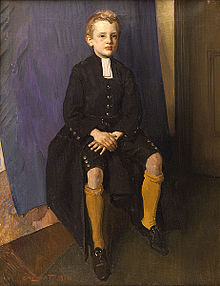 The composer Constant Lambert as a pupil, wearing the traditional uniform
The composer Constant Lambert as a pupil, wearing the traditional uniform
Links with the City and the Lord Mayor of London are maintained, with an annual parade through the City of London on St. Matthew's Day and a regular place in the Lord Mayor's Show.
One of the Christ's Hospital traditions is marching into lunch with the band, which is done each day except Sunday, weather permitting.
Another is the annual speech-day parade, where the Lord Mayor of London and his procession watch the school perform a march-past through the main quad. They also join the school in chapel for a grand service, and eat lunch with the Grecian year and their parents. Lastly they move to Big School to hear the Senior Grecian's oration and witness the Grecian prize-giving. This is always on the last day before the Summer Half Term.
Uniform
The school's Tudor uniform: belted, long blue coats, knee-breeches, yellow socks, and bands at the neck. The uniform has been in place since 1552.[6] The nickname "Blue-coat School" comes from the blue coats worn by the students – however, the nickname used within the school community itself is "Housey" and the long coat is called a "housey coat".[citation needed]
Second and third form pupils wear a simple leather belt with a buckle. When pupils reach their "Little Erasmus" (year 9), they are presented with more elaborate hallmarked sterling silver 'broadie' buckles and belts, which the pupils keep after leaving the school.[citation needed]
A complementary uniform was introduced for girls on re-unification of the schools in 1985– knee length pleated skirt, summer jacket, yellow socks (for the boys and junior girls), and grey socks or grey/black tights for senior girls, as well as the long coat in winter, and the bands.[citation needed]
By 2011 students and alumni stated that they see the uniform as important way of giving the school a unique identity and unifying the school. Around that time the administrators had discussed the idea of updating the uniform. The school's 800 students voted; over 95% voted in favor of keeping the original uniform.[6]
Chapel and religion
As a "religious, royal and ancient foundation", the school chapel is central to Christ's Hospital life.
As part of the commemoration of the fifty years since the artist's death, the chapel hosted an exhibition of the "Brangwyns": cartoons by the artist Frank Brangwyn of the paintings the artist made for the chapel depicting scenes from Christian history such as St Peter standing up with the eleven, famous conversions, and martyrdoms.
At the Leaving Service, school-leavers receive a Bible as a reminder of the school's commitment to Christian values.
Children are encouraged to explore their own worldview in the Theology and Philosophy classes. Pupils are encouraged to respect different religions and cultures. The school welcomes children from other religious and cultural backgrounds.
Beating Retreat
At the end of every academic year, the Christ's Hospital school band marches out from the music school, and perform a parade in the Quadrangle. The parade lasts for approximately an hour, during which they perform maneuvers with ranks of the band members forming shapes whilst playing their instruments. Towards the end, the snare drummers, and in 2011 the cymbals too, perform "splits" a combination of drum solos and trickery with the drumsticks. It is usually an emotional time, as it is the last time the 'Grecians' will play for the school band.
Societies and clubs
- Christ's Hospital Scout Troop: founded in 1918, it is one of the oldest Scout troops in the country. Based in the Lord Wakefield Scout Headquarters, which is centrally located on the school grounds.
- Christ's Hospital Debating Society: The Debating Society holds a debate each Friday evening.
 The Breakfast Club logo
The Breakfast Club logo
- Christ's Hospital Breakfast Club: founded in 2010, the Breakfast Club meets every Friday morning to have breakfast together in the Dining Hall. Guests, by invitation only, have included the Headmaster and his wife, the Clerk, and various other members of the teaching staff. The Club have often put on themed breakfasts including Valentine's Day, the Royal Wedding 2011 and Armistice Day.[citation needed]
Music
Christ's Hospital has a long and distinguished musical tradition and has one of the largest school music departments in the country, with around 35 visiting staff and 9 residential staff. The residential music staff include:
- Adrian Bawtree MBE MA (Oxon) FRCO LRAM, Director of Music (succeeding Bruce Grindlay MA (Cantab) BMus (Cantab) FRCO (CHM))
- Steve Titchener BA MMus, Head of Brass and Music technology (currently Assistant Musical Director with the National Youth Jazz Orchestra)
- Tim Callaghan LRAM, Head of Strings
- Terry Whittingham, Bandmaster (a former Bandmaster of the Queen's Own Highlanders)
Famous alumni of Christ's Hospital Music School include conductors Sir Colin Davis, Charles Hazlewood, Adrian Bawtree, and Simon Joly, trumpeter David Mason (formerly Principal Trumpet of the Royal Philharmonic Orchestra), tenor Charles Corp, and composer and conductor Constant Lambert.
The school's chapel (seating 1,000 and second only in size to Lancing College Chapel)[citation needed] has a large five-manual Rushworth and Dreaper organ, one of four organs in the School (the others being a 3-manual 1829 Hill in Big School, played on by Mendelssohn and Karg-Elert, a 2-manual Father Willis in the Dining Hall, and a Flight and Robson chamber organ in the Court Room). The near 150-strong Chapel Choir has made many recordings and through these has earned an excellent reputation. Throughout the school's history, many musically gifted pupils have gone on to take up choral and organ scholarships at Oxford and Cambridge or have gained places at leading music conservatories. The school has a Symphony Orchestra and many other smaller choirs and instrumental ensembles, along with the celebrated annual House Singing Competition. The Music Department organises a concert every February at St John's, Smith Square in London, thus providing an excellent performance opportunity for budding soloists and chamber musicians, alongside masterclasses with musicians such as Stephen Kovacevich, Hugh Bean, Adrian Thompson and Patrick Russill. The school is also famous as the first place in England to host a complete cycle of the chamber music of Brahms, under the direction of the then Head of Piano John Thwaites.
Christ's Hospital was featured in the first series of the reality television programme Rock School, in which Gene Simmons of KISS helped a group of pupils form their own rock band.[7]
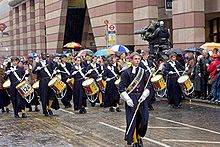 The Christ's Hospital Band participating in the Lord Mayor's Show in 2008
The Christ's Hospital Band participating in the Lord Mayor's Show in 2008
The school's most famous ensemble is its band, simply named Christ's Hospital Band. It plays for the daily parade and performs in the annual Lord Mayor's Show in the City of London. The band also has a regular engagement each summer at Lord's Cricket Ground. The band played in the prestigious Rose Bowl Parade in California in 2002. The band led the procession at the Queen's 80th birthday in London on 21 April 2006 and has played at Twickenham Stadium on a number of occasions.
Drama
An Arts Centre complex (architect: Bill Howell) was opened in 1974 including a theatre with Tudor style auditorium, music school extension, Octagon rehearsal/performance space and classrooms.
The Christ's Hospital Arts Centre served as a principal arts venue for Horsham and the surrounding area until the establishment of an arts centre in Horsham in the 1980s. A programme of performances continues to be open to the public. Former notable pupils in theatre and film include Jason Flemyng, Leo Gregory,[8] James D'Arcy, Michael Wilding, and Roger Allam.
Art
Christ's Hospital has many famous paintings, such as the "Verrio" (painted by Antonio Verrio), the Brangwyn cartoons, and the only picture of Queen Victoria on a horse outside the Royal Collection. Many visitors come to see the paintings. Christ's Hospital Art School gives students the opportunity to work in many different mediums, having halfterms alternated between DT and Art.
Ofsted
Christ's Hospital was inspected by Ofsted and the Independent Schools Inspectorate (ISI) in September 2009. Ofsted highlighted much that was very good or outstanding at CH. The ISI report concluded that Christ's Hospital is, "conspicuously successful in its aim to provide a high quality boarding experience and a broad and challenging academic education. The strong house communities and the care and concern shown by all staff contribute strongly to the outstanding relationships and high standards of pupils." However, due to failure to comply with some "safeguarding" rules, the overall quality of welfare provision at the school was rated as "inadequate" by the Ofsted inspectors in spite of all the good work elsewhere.[9] The Head Master was 'disappointed' with this and has rectified the errors and requested a new inspection to regrade the school.
Organisation of the school
Year groups
The ages currently range from 11 to 18, although "Leigh Hunt" was originally a prep school which took children from the ages of 8/9, in preparation for the senior school.
The school uses traditional year group names. The nomenclature used by the school and its National Curriculum equivalence are shown in the following table:
School
Nat.Curric. equiv.
Second Form (2nd)
Year 7
Third Form (3rd)
Year 8
Little Erasmus (LE)
Year 9
Upper Fourth (UF)
Year 10
Great Erasmus (GE)
Year 11
Deputy Grecians (Deps)
Year 12 (lower sixth)
Grecians
Year 13 (upper sixth)
Accommodation
The school houses are named after notable Old Blues, primarily writers. Each house has an "A" and "B" side, each housing roughly 45 pupils arranged from west to east as follows:
- Grecians West (mixed)
- Peele – George Peele (boys)
- Thornton – Edward Thornton[10] (girls)
- Middleton – Thomas Fanshawe Middleton (boys)
- Coleridge – Samuel Taylor Coleridge (girls)
- Lamb – Charles Lamb (boys)
- Barnes – Thomas Barnes (girls)
- Maine – Henry James Sumner Maine (boys)
- Leigh Hunt – James Henry Leigh Hunt (girls)
- Grecians East (mixed)
The sixteen original main boarding houses stretch from Peele to Leigh Hunt along The Avenue, built as four H-blocks on either side of the main Quad. Leigh Hunt was originally the pair of preparatory houses, Prep A and Prep B, until converting to junior houses on the abolition in 1964 of entry at the age of nine.
The sixteen original houses provided two dormitories (Upper Dorm and Lower Dorm) sleeping up to about 30 boys each. As the merger of the boys and girls approached, some dormitories were divided into cubicles, and subsequent developments created dormitories accommodating about twelve pupils each. Since 2001 there has been a rolling refurbishment programme, with the refurbished houses providing a range of accommodation: four-bed rooms for the junior pupils to one-bed rooms for the more senior pupils.
Until 1964, boys at Horsham lived in all-through houses from 2nd Form to Grecians (with the exception of Prep A and Prep B). Then houses were divided into senior houses (Peele, Thornton, Middleton, Coleridge and Lamb) and Junior houses (Barnes, Maine, Leigh Hunt) with boys transferring to a senior house after Little Erasmus. In conjunction with the merger, a further reorganisation occurred with each house converting to a senior side and a junior side. This system reverted to the all-through houses in 2000; now from 2nd Form to Deps.
Grecians West and Grecians East were completed early in 2001 and provide individual study bedrooms plus several general common rooms and kitchenettes shared by a group of seven to ten pupils in the final year (Grecians) living a transitional style of life in preparation for university or life beyond school.[11]
With the transformation of Thornton from boys' houses to girls' houses in 2007, there are now an equal number of girls and boys at the school for the first time in its history.
Old Blues
- See List of notable Christ's Hospital Old Blues
Staff
Notable members of staff have included:
- Edward Baldwin, 4th Earl Baldwin of Bewdley
- Edward Buck
- Samuel Cobb
- Gerald Davies
- Ralph Henry Carless Davis
- John Flamsteed
- George Andrew Jacob
- Derrick Somerset Macnutt
- William Hamilton Fyfe
- C. S. Lang
- Elizabeth Keane[clarification needed]
- Steve Gatting
- Bruce Grindlay (departing Precentor)
- William Wales
- Dr David Newsome
See also
- Christs Hospital railway station
- List of Victoria Crosses by School
- The Royal Hospital School
Notes
- ^ Council of Almoners Annual Review 2005/2006
- ^ CHRIST'S HOSPITAL FOUNDATION, Registered Charity no. 306975 at the Charity Commission
- ^ CHRIST'S HOSPITAL SCHOOL, Registered Charity no. 1120090 at the Charity Commission
- ^ John & Frances West & their charities
- ^ http://west-group.hami.co.uk/html/weststory.html
- ^ a b "Students Vote to Keep Tudor Uniform." British Heritage 32, no. 2 (May 2011): 10. Academic Search Complete, EBSCOhost (accessed August 27, 2011).
- ^ Gene Simmons Rock School
- ^ Hodgkinson, Will (11 November 2005). "How I found my inner hippy". The Guardian (London). http://arts.guardian.co.uk/filmandmusic/story/0,,1639572,00.html. Retrieved 29 April 2010.
- ^ http://www.christs-hospital.org.uk/school-inspection-reports.php
- ^ Christ's Hospital, G.A.T. Allan, Shepperton 1984, ISBN 0863640052
- ^ http://www.christs-hospital.org.uk/parents-handbook-dec09.pdf
References
- Hang on Tight Christ's Hospital:from Girlhood to Governor ISBN 978-1-84104-499-6
- Christ's Hospital, G.A.T. Allan (revised J.E. Morpurgo), London 1984, ISBN 0-86364-005-2
- Christ's Hospital quad and Grecians East photos by Sergiu Panaite
- Christ's Hospital: A Short History, Nick Plumley 1986 (no ISBN)
- Christ's Hospital in the Victorian Era, Ken Mansell, Ashwater Press 2011 ISBN 9780956256126
External links
- Christ's Hospital
- Christ's Hospital Association website (Alumni website)
This article incorporates text from the public domain 1907 edition of The Nuttall Encyclopædia.
Categories:- Boarding schools in West Sussex
- Educational institutions established in the 1550s
- Former buildings and structures of the City of London
- Independent schools in West Sussex
- Schools with Combined Cadet Forces
- 1552 establishments in England
- Member schools of the Headmasters' and Headmistresses' Conference
- Horsham
- Christ's Hospital
- Organisations based in England with royal patronage
- Charities based in West Sussex
Wikimedia Foundation. 2010.




